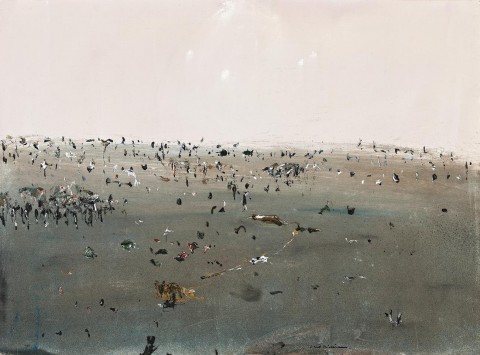BURNT GRASS, LYSTERFIELD, 1968
FRED WILLIAMS
gouache on paper
56.5 x 76.5 cm
signed lower right: Fred Williams
artist's label attached verso with number, artist’s name, medium and size
Skinner Galleries, Perth
Private collection, Perth, acquired from the above in 1970
Thence by descent
Private collection, Perth
probably: Fred Williams, Rudy Komon Gallery, Sydney, 5 – 29 November 1969, cat. 6 (as ‘Burnt Landscape’, label attached verso)
Fred Williams: Perth Festival Exhibition, Skinner Galleries, Perth, 23 February – 16 March 1970, cat. 19
We are grateful to Lyn Williams for her assistance with this catalogue entry.
Fred Williams’ distinctive views of the Australian bush can be read as exercises in form and gesture, with the barest of markings highlighting the rare landmarks in an otherwise uniform landscape. The series of oils and gouaches created in February 1968, in the immediate aftermath of a devastating bushfire whose path ran right up to artist’s home in Upwey, near Lysterfield, however, are quite literal in their empty desolation. Burnt Grass, Lysterfield, 1968 is an expansive, almost birds-eye view of the ravaged landscape, its singed foundations laid bare in uneven washes of ashy ground. The undergrowth stripped back by the fire, the Burnt Grass, Lysterfield landscape leaves only isolated tree stumps, clusters of smouldering trunks, rendered with casual dots and brushmarks supplemented by streaks of fresh local charcoal and splashes of red madder live embers. The horizon line imperfectly bisects heaven and scorched earth, the hazy sky hanging low and quiet.
Williams’ view, while impersonal in its panoramic amplitude, was in fact recorded en plein air. The personal experience of an environmental disaster on this scale was keenly felt by the artist, his awe feeding directly into a frenzied artistic output which produced masterpieces such as Burnt Landscape, 1968, and After the Fire, 1968, a gouache, in the collection of the National Gallery of Australia. Burnt Grass, Lysterfield was first exhibited at Rudy Komon Gallery in Sydney in November 1969, alongside two oil paintings and one other gouache from the Bushfire series. It was then sent to Perth, early the following year, for the Perth Festival of the Arts, where the artist presented a major survey of works produced between 1966 – 1969, reflecting on transitions and resolutions between his most recent series.
The Bushfire works had three successive themes: the approaching fire, the burnt landscape, and the subsequent regeneration of ferns. The logical succession of these themes expressed Williams’ appreciation for the awesome magnificence of the Australian landscape. The resulting works, of which Burnt Grass, Lysterfield is no exception, are amongst his most emotionally charged pictures. The unsettling hazy stillness gives way to a romantic dramatisation of the national experience. Patrick McCaughey notes in his 1980 monograph: ‘It was as though the country were seen in negative and the fragmentary remains of the bush seen correspondingly with flickering brilliance and clarity, set off against the ground in pure hues’.1
1. McCaughey, P., Fred Williams, Bay Books, Sydney and London, 1980, p. 203
LUCIE REEVES-SMITH
